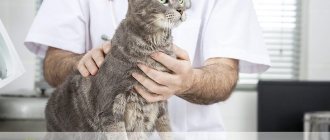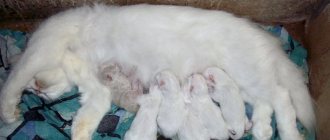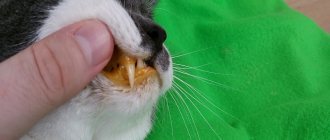Course of pregnancy
During the entire period of gestation, the animal must be under the constant supervision of a doctor and owner.
The usual physiological process of development of a fertilized egg in a cat’s body lasts from 55 to 63 days. This period is influenced by the breed of the animal and the number of kittens that should be born. Only a pregnancy with a large number of fetuses can reduce the gestation time. The picture of the development of the special state of the animal is as follows:
If the mating is successful, then the first few weeks for the animal become more drowsy.
- In the first 3 weeks, behavior changes: the cat sleeps a lot of time, eats more and moves less. Closer to 21 days, the nipples swell and become pink.
- During 4-6 weeks, characteristic features of pregnancy appear. The belly gradually becomes rounder, and after 40 days it begins to grow rapidly. During this period, the veterinarian can feel the number of embryos.
- At 7-9 weeks, the cat's appetite decreases, but she still sleeps a lot. If you put your hand on your stomach you can feel the babies moving. The closer the 63rd day, the lower the stomach drops (located in the hip area). The animal does not leave its owner, but at the same time is looking for a place to build a nest for its offspring.
Visible symptoms
The fact that a cat is pregnant can be assumed by changes in its character and behavior; only a veterinarian can make an accurate diagnosis. There are no obvious symptoms to be noticed immediately after mating; the first characteristic signs that will indicate the imminent appearance of kittens will appear after fertilization only after 3 weeks. The following visible, distinctive signs are distinguished:
A manifestation of this condition in an animal is an enlargement of the mammary glands.
- enlarged mammary glands;
- low physical activity;
- lethargy and drowsiness;
- lack or increase in appetite;
- change in taste preferences.
Preparing for childbirth
In most cases, cats independently prepare for childbirth, starting to do this especially actively from about 7 weeks of pregnancy. This is expressed in finding a quiet and secluded place, arranging some kind of nest by dragging soft rags, etc.
A person can help his pet in the following ways:
- From about the middle of pregnancy, provide the cat with a box or bed, place it in a remote place and line it with something soft. Immediately begin to accustom the animal to this place, periodically putting it down and rewarding it.
- 2 weeks before the expected birth, try to provide your cat with a calm environment so that she does not try to escape or isolate herself.
- If there are children at home, you should consider giving the cat a separate room for a while, which is especially important in the last 14 days of gestation.
Important!
In more than 90% of cases, labor in cats occurs without problems and without the need for human intervention. If you are still too worried, it may make sense to call a specialist at home.
Prenatal checkup
The examination should be carried out by a veterinarian several times throughout the pregnancy. This allows you to monitor the condition of the animal and respond in time to any problems if they arise.
After the examination, the doctor gives the owners a number of instructions, for example:
- ban on the use of anthelmintic drugs;
- ban on the use of flea products;
- recommendations for preparing a diet;
- recommendations for reducing cat activity in the last weeks before giving birth, etc.
We advise you to find out in advance where and how to seek veterinary help if an unforeseen situation arises.
Is there toxicosis?
With the onset of pregnancy, significant changes occur in the animal’s body, so at the initial stage, pregnant cats may develop a pathological condition that is accompanied by nausea. The unpleasant sensations last for 10-14 days and disappear by the end of 3-4 weeks.
Main reasons
The list of root causes for the development of a pathological condition can be quite large and include a variety of circumstances. Therefore, it is important to provide the most suitable conditions for a cat expecting offspring and monitor its condition. The following factors may cause the development of early toxicosis in an animal:
Worm infestation in an animal can enhance the manifestations of this condition.
- parasitic worms (worms);
- presence of chronic infection;
- disruption of the endocrine system;
- decreased body resistance;
- hormonal disbalance;
- poor content;
- genetic features.
Despite the fairly large list of possible causes for the development of a pathological condition in a pregnant cat, toxicosis during pregnancy is a rather rare phenomenon and short-lived. When a cat is vomiting, there is no need to resort to special treatment, but if the pet’s health is alarming and causes concern, you need to seek help from a veterinarian.
Care and nutrition during pregnancy
A pregnant cat requires more careful care, because her body needs all kinds of support so that the offspring can fully develop and the health of the expectant mother remains normal. During this period, cat owners should take care of the following nuances:
- Diet - during pregnancy, you should feed the cat more often, while gradually reducing the portion size, but offering food at shorter intervals. It is also important to take care to enrich your pet’s diet with calcium (special food or more milk if the cat eats natural food).
- Special attitude - it is important to completely protect the pet from stress, not to punish, even if the expectant mother has done something wrong.
- Exercise - although pussies become less mobile during pregnancy, they should not be denied active games if the animal itself desires this, muscle activity is important.
Note!
It wouldn't hurt to take your pet to the veterinarian. The first time this should be done as soon as pregnancy is noticed, the second time - closer to 6-7 weeks.
Morning vomiting in cats
The urge to vomit in the morning, as mentioned earlier, is one of the early symptoms of pregnancy in felines. This is a clear sign of hormonal changes, that is, the animal’s body is actively preparing to bear offspring.
Vomiting usually occurs in the 3rd week of pregnancy and goes away on its own after 3-4 days. If after this period of time the symptom remains, this is a good reason to go to the veterinarian.
Why is it dangerous?
A minor physiological disorder develops slowly, without causing harm to the animal or embryos, and disappears just as slowly. If the development of pregnancy is accompanied by a rapidly deteriorating health condition caused by severe intoxication, an urgent need to respond, since such a situation is dangerous for the life of the pet and small kittens. Worrying signs that are not typical for toxicosis should cause concern:
The accompanying decrease in the pet's temperature is dangerous for the life of her offspring.
- Sudden drop in body temperature. Leads to a slowdown in life processes, which in the early stages can result in the “fading” of the fetus.
- Disorder. Diarrhea caused by poisoning, an intestinal virus or a cold leads to miscarriage.
- Loss of large amounts of fluid. Increased intoxication of the body primarily negatively affects kittens.
How to avoid diarrhea during pregnancy, how and how to protect yourself?
Following these 5 simple rules will greatly reduce the likelihood of diarrhea during pregnancy.
- Don't forget about personal hygiene - wash your hands before eating. Do not consume expired products;
- Do not eat in establishments with a dubious reputation;
- Do not eat food that is not the first freshness;
- Don't overeat;
- When planning a pregnancy, treat chronic diseases.
And one more thing: we all carry a mobile phone with us everywhere. According to the rule of etiquette, on which side of the plate should it be? Jokes aside, as a result of a recent study, scientists found that every sixth phone contains E. coli - bacteria that live in feces. E. coli “with a slight movement of the hand” moves to your plate! There is only one conclusion - wash your hands after visiting the toilet!
Health to you and your baby!
What to do?
Help your cat survive 10 days of discomfort, perhaps by following simple rules:
- Ensure complete rest. During sleep, immune defenses are restored. Restful sleep reduces the risk of contracting diseases during such a difficult period.
- Comfortable conditions. The animal may be nervous, it is important to support the pet, calm it down and pay attention to it.
- Nutrition. There is no need to force people to eat; it is better to offer several types of foods to choose from. It is better to reduce the portion size and increase the number of meals. Water or milk should be available at all times.
It is important to understand that the use of medications for pregnant women is prohibited. If the development of toxicosis occurs against the background of chronic pathology, treatment should only be prescribed by a specialist. You should not resort to self-medication; such a thoughtless approach can only provoke a complication that will negatively affect the cat’s health, but also cause pathological abnormalities in the intrauterine development of the fetus.
Age and characteristics of puberty
Cats live in the wild for up to five to eight years, and with good care near humans they can live up to seventeen to twenty. Long-living record holders celebrated up to thirty birthdays. At the same time, initially the body of female small cats is created in such a way as to prepare for the first pregnancy at a young age: approximately 5-7 months, depending on the breed. Small cats, such as Siamese and Orientals, mature earlier, large cats - British cats, Maine Coons - later. It is not difficult for the owner to guess whether the “girl” is ready for mating, since behavioral patterns change dramatically:
- A few days before the first heat, the cat becomes more affectionate and clings to its owner. This change can be especially noticeable in independent animals, which are usually not prone to excessive expression of their feelings.
- Some individuals begin to mark their territory with urine. This problem is less pronounced in females than in males, but is also quite common, especially if there is more than one animal in the house. In this way, the cat shows its readiness to mate and its place in the hierarchy.
- As soon as the “rut” period begins, the cat’s behavior changes even more. She begins to meow protractedly, announcing to all the surrounding cats that she is ready to become pregnant.
- Many young pussies feel bad during heat, they seek help from the owner, and become overly affectionate. Scientists believe that they suffer from painful sensations.
- If fertilization occurs, estrus stops after a day or two. Sometimes this time is enough for the female to be attracted to another cat, as a result of which cats can become pregnant with several males.
This is due to the fact that although the first heat occurs in cats at a young age, they are still too young, and their bodies are fragile. The offspring of such animals are weak and often non-viable. The young mother herself also suffers from too early pregnancy, and may even die in childbirth.
Clinical symptoms at the beginning of pregnancy
Already in the first few days after conception, the following conditions and changes in the body of a pregnant girl may develop:
- Early factor. This is the name of a special substance that is released 1-2 days after fertilization. According to the data obtained, it is found in 67% of examined women whose pregnancy was subsequently confirmed.
- Bloody discharge from the genital tract. They may have a yellowish or pinkish tint and appear when the fertilized egg attaches to the uterine walls. This usually happens at the end of the first, beginning of the second week after conception.
- The increase in basal temperature that appeared at the time of ovulation persists for a long time if fertilization has occurred. Its measurement can indirectly confirm the occurrence of pregnancy. The general body temperature may also rise to 37 degrees.
- Paresthesia, pain and cramps in the calf muscles. As a rule, they occur late in the evening or at night, causing sleep disturbances and even insomnia.
- A decrease in blood pressure, which is manifested by severe weakness and dizziness. With significant hypotension, fainting is possible. The risk of developing this condition is prolonged exposure to a stuffy, unventilated room or standing position.
- Decreased immunity. Manifested by frequent colds. Also, against the background of immunodeficiency, pregnant women may be bothered by genital candidiasis or, in other words, thrush.
- Increased urge to urinate. Most often this symptom appears in later stages of pregnancy, but it can also occur in the first days.
Despite the huge number of signs, most often a woman pays attention to a delay in menstruation. And for good reason. This is the most obvious and accurate symptom that should lead you to certain thoughts. Of course, menstrual irregularities occur in a huge number of pathological conditions. However, if you are planning a pregnancy, a delay may be the first bell indicating the onset of the long-awaited conception.
Immediately after the onset of the above sign, you can conduct a test that is sensitive to an increase in hCG.
Vomiting in kittens
Newborn babies who feed on milk from their mother often spit it up when they overeat. Older individuals may suffer from mild nausea after running quickly or after excessive activity. Kittens who have already switched to solid food may also suffer from nausea at first, as their stomachs need to get used to the new food. All of these conditions are completely normal and do not require veterinary intervention.
But if you notice parasites, traces of bile or blood in your baby’s vomit, immediately go to a specialist. Since the immunity of kittens is much weaker than that of an adult animal, they will need an individual treatment regimen with gentle drugs.











